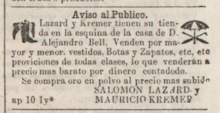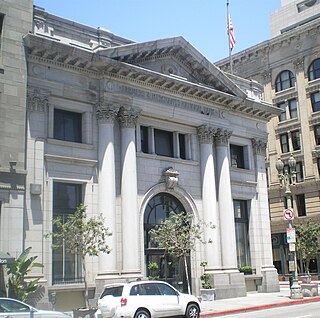
Farmers and Merchants Bank (F&M) is a historic lending institution (1871−1952) based in Downtown Los Angeles, California. It is known both for its architecture and its pivotal role in the economic development of early Los Angeles. Other, non-related "F&M Banks" exist in many cities and towns across the United States.

Lazard Inc. is a financial advisory and asset management firm that engages in investment banking, asset management and other financial services, primarily with institutional clients. It is the world's largest independent investment bank, with principal executive offices in New York City, Paris and London.

Broadway, until 1890 Fort Street, is a thoroughfare in Los Angeles County, California, United States. The portion of Broadway from 3rd to 9th streets, in the Historic Core of Downtown Los Angeles, was the city's main commercial street from the 1910s until World War II, and is the location of the Broadway Theater and Commercial District, the first and largest historic theater district listed on the National Register of Historic Places (NRHP). With twelve movie palaces located along a six-block stretch of Broadway, it is the only large concentration of movie palaces left in the United States.
Joseph P. Loeb (1883–1974) was an American lawyer and public servant.
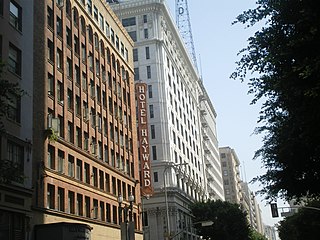
Spring Street in Los Angeles is one of the oldest streets in the city. Along Spring Street in Downtown Los Angeles, from just north of Fourth Street to just south of Seventh Street is the NRHP-listed Spring Street Financial District, nicknamed Wall Street of the West, lined with Beaux Arts buildings and currently experiencing gentrification. This section forms part of the Historic Core district of Downtown, together with portions of Hill, Broadway, Main and Los Angeles streets.
Main Street is a major north–south thoroughfare in Los Angeles, California. It serves as the east–west postal divider for the city and the county as well.

Solomon Lazard, also known as S. Lazard, (1827–1916) was an entrepreneur in 19th century Los Angeles, California, a member of the city council there in 1854, and founder of S. Lazard & Co.

Bell Block was a building in Los Angeles in the U.S. state of California. Situated on the corner of Aliso and Los Angeles streets, it was built in 1845 by Captain Alexander Bell. It was one of the few two-story adobe buildings in the then one-story adobe town of Los Angeles.
Joseph W. Wolfskill and Louis Wolfskill were brothers who were members of the Los Angeles, California, Common Council, the legislative arm of that city's government, between 1874 and 1884. They were landowner successors to their pioneer Southern California father, William Wolfskill.
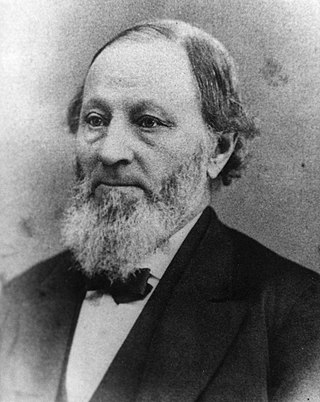
Joseph Newmark (1799–1881) was a Prussian-American businessman in New York City and Los Angeles and a member of the Newmark family of Southern California. He helped found Jewish congregations in both cities and later became an ordained rabbi.

Maurice Kremer (1824–1907) was an American businessman and civil servant.
Marc Eugene Meyer was an American businessman and was president of Lazard Frères in the United States. Born in Strasbourg, France, he migrated to California as a teenager, living in San Francisco and Los Angeles until 1893 when he moved to New York City in his role with Lazard. He was awarded the Legion of Honor in 1920.
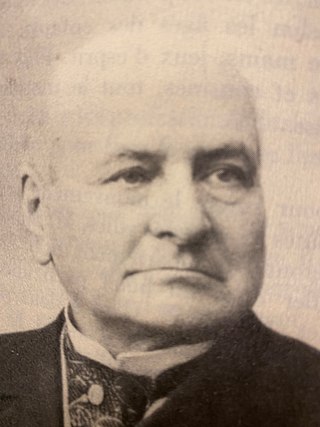
Simon Lazard was a Franco-American banker who co-founded Lazard Frères & Co., reorganized in 2000 as Lazard.

Harris & Frank was a clothing retailer and major chain in the history of retail in Southern California, which at its peak had around 40 stores across Southern California and in neighboring states and regions. Its history dates back to a clothing store founded by Leopold Harris in Los Angeles in 1856 near the city's central plaza, only eight years after the city had passed from Mexican to American control. Herman W. Frank joined Harris in partnership 32 years later in 1888.

Myer Siegel was a Los Angeles–based department store, founded by Myer Siegel (1866–1934), specializing in women's clothing.
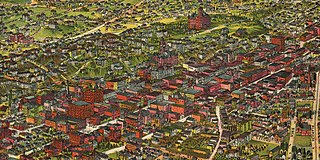
The late-Victorian-era Downtown of Los Angeles in 1880 was centered at the southern end of the Los Angeles Plaza area, and over the next two decades, it extended south and west along Main Street, Spring Street, and Broadway towards Third Street. Most of the 19th-century buildings no longer exist, surviving only in the Plaza area or south of Second Street. The rest were demolished to make way for the Civic Center district with City Hall, numerous courthouses, and other municipal, county, state and federal buildings, and Times Mirror Square. This article covers that area, between the Plaza, 3rd St., Los Angeles St., and Broadway, during the period 1880 through the period of demolition (1920s–1950s).

Ville de Paris was a department store in Downtown Los Angeles from 1893 through 1919.

7th Street is a street in Los Angeles, California running from S. Norton Ave in Mid-Wilshire through Downtown Los Angeles. It goes all the way to the eastern city limits at Indiana Ave., and the border between Boyle Heights, Los Angeles and East Los Angeles.

Retail in Southern California dates back to its first dry goods store that Jonathan Temple opened in 1827 on Calle Principal, when Los Angeles was still a Mexican village. After the American conquest, as the pueblo grew into a small town surpassing 4,000 population in 1860, dry goods stores continued to open, including the forerunners of what would be local chains. Larger retailers moved progressively further south to the 1880s-1890s Central Business District, which was later razed to become the Civic Center. Starting in the mid-1890s, major stores moved ever southward, first onto Broadway around 3rd, then starting in 1905 to Broadway between 4th and 9th, then starting in 1915 westward onto West Seventh Street up to Figueroa. For half a century Broadway and Seventh streets together formed one of America's largest and busiest downtown shopping districts.
Leon Loeb (1845–1911) was a French-born American businessman who owned and operated the first department store in Los Angeles. He was a member of the Newmark family through marriage.


